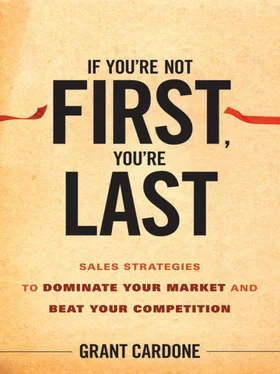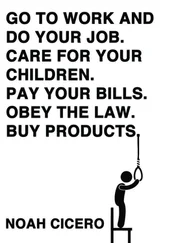Grant Cardone - If You're Not First, You're Last - Sales Strategies to Dominate Your Market and Beat Your Competition
Здесь есть возможность читать онлайн «Grant Cardone - If You're Not First, You're Last - Sales Strategies to Dominate Your Market and Beat Your Competition» — ознакомительный отрывок электронной книги совершенно бесплатно, а после прочтения отрывка купить полную версию. В некоторых случаях можно слушать аудио, скачать через торрент в формате fb2 и присутствует краткое содержание. Год выпуска: 2010, ISBN: 2010, Издательство: Wiley, Жанр: small_business, на английском языке. Описание произведения, (предисловие) а так же отзывы посетителей доступны на портале библиотеки ЛибКат.
- Название:If You're Not First, You're Last: Sales Strategies to Dominate Your Market and Beat Your Competition
- Автор:
- Издательство:Wiley
- Жанр:
- Год:2010
- ISBN:9780470645918
- Рейтинг книги:3 / 5. Голосов: 1
-
Избранное:Добавить в избранное
- Отзывы:
-
Ваша оценка:
- 60
- 1
- 2
- 3
- 4
- 5
If You're Not First, You're Last: Sales Strategies to Dominate Your Market and Beat Your Competition: краткое содержание, описание и аннотация
Предлагаем к чтению аннотацию, описание, краткое содержание или предисловие (зависит от того, что написал сам автор книги «If You're Not First, You're Last: Sales Strategies to Dominate Your Market and Beat Your Competition»). Если вы не нашли необходимую информацию о книге — напишите в комментариях, мы постараемся отыскать её.
If You're Not First, You're Last: Sales Strategies to Dominate Your Market and Beat Your Competition — читать онлайн ознакомительный отрывок
Ниже представлен текст книги, разбитый по страницам. Система сохранения места последней прочитанной страницы, позволяет с удобством читать онлайн бесплатно книгу «If You're Not First, You're Last: Sales Strategies to Dominate Your Market and Beat Your Competition», без необходимости каждый раз заново искать на чём Вы остановились. Поставьте закладку, и сможете в любой момент перейти на страницу, на которой закончили чтение.
Интервал:
Закладка:
When ending an activation call with a past client, always reiterate your original reason for calling:
“If there is anything we can do for you, let me know. By the way, what is your best mailing address? I need to send you something.” (Make sure you get it!) “Great. And what is your current e-mail address?” Again, don’t get off the phone without gathering this information; you will use it in your follow-up mailing and personal visit. Do not evaluate the success of the call based on what happens. Simply acknowledge the fact that you have reactivated an old client—something that is going to be helpful in the future as you continue to contact clients via phone calls, mailings, e-mails, and personal visits.
There is another, more aggressive approach that you can take. It would start the same way as the previous call:
“John, Grant Cardone here. How are you? Hey, I’m calling you for two reasons: First, I haven’t spoken with you in some time and wanted to catch up. How are you, the family, and your business?” (Again, keep this short, unless the person wants to talk.)
Then you would discuss information that’s more specifically tailored to this particular client:
“The second reason I am calling is that I was looking at your account, and I realized that we’ve just introduced some special programs that could move you up in product line without changing your monthly expense. Would that be of interest to you?” (This technique is called “improve the client’s situation.”)
The moment I notice any type of contraction in the economic cycle, I have a set of actions I immediately deploy, one of which is to increase communication with existing clients by offering to improve their situation. I don’t wait until the media begin talking about how bad things are getting in the market; I proactively look for the cycles, and then take action before things get too out of hand. Your clients will automatically look for ways to reduce expenses during down times. I see this as an opportunity and start contacting clients with an offer to replace or add to their current product or service and reduce their monthly payments by extending their contract.
For instance, my firm sells long-term training and consulting contracts to businesses. Companies typically hire us, we agree on a price and then sell the contract to a third party, and the client then pays installments to a third party (finance company) for a set period of time. Let’s say a previous client has six months left to pay to the third party. We then get on the phone and call our client in order to renew the training contract before it matures, add training dates that the client is going to need anyway, and carry the balance owed over to a new contract with revised dates and terms, thereby reducing the customer’s payments. The client gets the training he or she needs at a lower monthly payment, and we get revenue and continue to service our client in a contracting market. It is most definitely win-win. But you have to think in creative terms of how to move your clients forward and reactivate them with new products and services.
Of course, not every client will take us up on our offer, nor is every client even qualified to do so. But this creative thinking and acting allows us to stay in frequent contact with customers and puts us back in the game.
I’ll bet you are trying to figure out how you can apply these scenarios to your business. Steps like these require that you take responsibility for all the parts of the cycle, aspects of which you might not have considered to be your responsibility in the past. You will not just be doing your job; you will be making sure all the other pieces get done as well. You have to do more than sell and promote when things get tough. You will be forced to assume control of all the tasks associated with gaining a client and getting the job done. There are probably fewer people in your organization now and you will have to take on more of a responsibility for each of the steps necessary to conquer business. Remember many of your work associates will be stuck in some other stage of recovery maybe even apathy so don’t count on them to respond with the same “attack” mentality that you do.
Also do not get lost in the details. In the case of lowering someone’s payments as I suggested in the previous example, do not concern yourself with whether you can deliver on the absolute idea of reducing your clients’ payments or providing a service at no cost but that the critical goal is to determine interest and open a sales cycle. “No cost” or “lower payments” are relative terms that mean something different to everyone. To the degree that your client displays interest and sees value in the offer, he or she will justify taking you up on it—or not. Don’t focus solely on how to close a transaction with this contact; just concentrate on reactivating your existing clients and creating interest in your products and services. The opportunities will validate themselves.
If the contact expresses an interest, that’s good, of course. But if not, simply return to the service part of the call:
“Well, thanks for taking the time to talk with me! Again, the main reason I called was to see if there is anything I could do for you to enhance the purchase you made with us.” End the call with, “Let me know if there is anything I can do for you. And by the way, I would love to catch up with you sometime over lunch.”
You don’t have to ask for business directly, but you do need to make contact. Second in importance to initiating the call is how you end it. It is vital to return to the original reason for calling and end on the positive, service intention of the call.
As with all calls you make, follow up this call with a letter, then set a time to make a personal visit. Combine the use of available technology like customer relationship management (CRM), database management, computer programs, data-scrubbing programs, and even electronic proposals with the phone, e-mails, social networking, and don’t forget personal visits to maximize your follow-up. The mail and Internet can be very powerful ways to stay in touch, but don’t rely on one or the other. For example, I created a computer program for automobile dealers that took the negotiating process away from the salesperson. The program, called EPencil TMelectronically generates the entire proposal and gives the company and presenter more credibility, speed, and delivery capabilities. The company can then use these electronic proposals to control and improve the sales experience as well as market its products in its mail programs, Internet responses, traditional advertising, and direct-mail offers.
Warning: Reactivating past clients has to be approached from a standpoint of offering service and taking interest in the client. Again, it is not a sales action . You should expect one order or assignment for every 10 to 12 calls you make. While this approach may not achieve a high return per call, it is essential to fully farming the opportunities you have already identified. You have invested a lot in these clients already, so continue to put forth time, energy, and effort toward those relationships that have already paid off. After all, you wouldn’t enter a gold mine and get a few ounces without going back in to gather the rest of the lode. The same holds true for your client list. Treat your clients like gold, and continue to mine by reactivating your relationships.
For those readers who are most “unreasonable” and dedicated: Take the earlier calls and add a referral component whereby you create an opportunity to have the old client replace him- or herself with another. After you’ve made some small talk and checked on the product, ask the following: “Who do you know who might be in the market for our product?” Personally, I would do this for every call, but I am a completely unreasonable individual who knows from experience that you only get what you ask for. And contrary to popular but misguided belief, asking for referrals cannot negatively affect you. It will in fact improve your clients’ perception of you as a professional. I am doing what every businessperson knows should be done—something that will be discussed in detail later.
Читать дальшеИнтервал:
Закладка:
Похожие книги на «If You're Not First, You're Last: Sales Strategies to Dominate Your Market and Beat Your Competition»
Представляем Вашему вниманию похожие книги на «If You're Not First, You're Last: Sales Strategies to Dominate Your Market and Beat Your Competition» списком для выбора. Мы отобрали схожую по названию и смыслу литературу в надежде предоставить читателям больше вариантов отыскать новые, интересные, ещё непрочитанные произведения.
Обсуждение, отзывы о книге «If You're Not First, You're Last: Sales Strategies to Dominate Your Market and Beat Your Competition» и просто собственные мнения читателей. Оставьте ваши комментарии, напишите, что Вы думаете о произведении, его смысле или главных героях. Укажите что конкретно понравилось, а что нет, и почему Вы так считаете.












